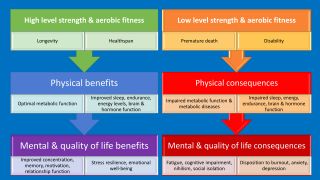Health
Why Training, Not Therapy, May Be a Ticket to Your Best Life
How to become fitter, stronger, and happier.
Posted September 8, 2023 Reviewed by Ray Parker
Key points
- Physical fitness includes aerobic fitness, strength, and muscular fitness.
- Your physical fitness is the best predictor of your future health and function.
- Stereotypes aside, you can achieve high fitness levels with modest time investments.

If your goal is to enjoy the highest quality of life possible—the ability to consistently feel, look, and function at an amazing level—then I have a suggestion that may sound unconventional coming from a mental health professional: Get in the best physical shape of your life.
Allow me to clarify what I am recommending. I'm not talking about the kind of decent physical shape you can achieve from following the Surgeon General's guidelines on exercise.1 Those are modest guidelines intended for people with modest goals.
Want to stay out of a nursing home? Avoid needing a walker or wheelchair. Postpone death and disability for a few years? If so, then following those guidelines may suffice.
But I'm guessing you want more than that out of life. Hopefully, a lot more. If I am right about you, and what you want is to routinely experience the best feelings and rewards that life can offer—such as vitality, positive emotions, focus, drive, adventure, sexual prowess, and confidence—you need to think bigger.
Instead of the Surgeon General's goal of 150 minutes of moderate physical activity a week, for instance, think of training to develop aerobic fitness high enough to put you in the top 5 percent of your age group. Instead of the Surgeon General's advice to engage in resistance training two times per week, think of training to become strong enough to be in the elite strength category for your age and sex.
Contrary to people's limited beliefs about their physical abilities, these milestones are readily achievable for most, often without any more time involved than meeting the Surgeon General's guidelines. Achieving these impressive levels of strength and fitness does, however, require more effort and more specific training strategies. Let's see if I can convince you that these latter costs are greatly exceeded by the rewards.
Health and happiness: where the body meets the mind
If I asked you what pushups and running have in common, your first response would likely be that both are forms of exercise. You might also identify that both are good for your health.
If so, you'd be right and perhaps even be surprised at just how right you were about the health benefits. According to the best scientific studies,2-3 for example, both running and pushup ability—as measured in controlled laboratory settings—are remarkably good predictors of how long and well a person will live.
How good? So good that a person in the bottom 25 percent of aerobic fitness was five times more likely to experience premature death compared to a person in the top 2 percent to 3 percent of aerobic fitness.3 So good that men capable of performing 40 or more push-ups experienced less than 1/10th the rate of cardiovascular disease events relative to men able to complete less than ten push-ups.2
So good that these physical fitness standards greatly outperformed conventional medical predictors of health events, such as diabetes and smoking status. As predictors, these results are so significant that your primary care physician might consider trading in their usual blood tests and stethoscope during your annual physical for an office treadmill and a pushup mat.
There is currently nothing your doctor can measure that can predict your future health and function as well as your physical fitness. Yet they probably don't measure it at all.
Now unless you're among a very select group of hardcore science readers, your above responses comparing running and pushups probably would not include identifying both as effective activities for improving happiness and mental health. However, there is equally compelling research showing that a person's aerobic capacity and physical strength are associated with increased emotional well-being4-6.
In short, increased aerobic and strength capacity can make you both healthier and happier. According to hundreds of studies, the fitter and stronger you are, the healthier and happier you are likely to be.
The reasons for the dual benefits of fitness and physical and mental health are numerous (e.g., see Figure 1 above). High aerobic and strength capacity greatly increases our ability to pursue goals, reduces injury risk and effort level when performing challenging activities, upregulates energy pathways in our brain and muscles, optimizes hormone and neurotransmitter function, improves memory and other cognitive abilities, enhances mitochondrial number and function, decreases chronic inflammation, promotes microbiome diversity, and produces higher quality sleep, among many other physiological and behavioral benefits.
Given this expansive list of favorable changes occurring across the brain and body, how could the benefits of excellent physical fitness not also extend to the psychosocial domains of happiness and quality of life?
Although it takes effort and training strategies to increase physical fitness, the process doesn't have to become a part-time job. You can dramatically improve your aerobic fitness, for example, what experts call your VO2 max (your ability to take in and use oxygen), by engaging in just 1-2 high-intensity workouts per week lasting 20-40 minutes.
You can similarly make large improvements in your strength and muscle size in just 2-3, 30-45-minute training sessions a week. Physical fitness training, including the enormous mental health and quality of life benefits resulting from physical fitness training, is a quality over-quantity endeavor.
Imagine transforming your body, mind, and quality of life over the next couple of years with just 2-3 hours/week of invested time and effort. By comparison, even the most skillful financial planners can only dream of having the kind of consistent return on investment (ROI) that fitness provides for our quality of life.
Summary
You have the potential to feel great, look great, and do amazing things. Not just for today or even this year, but for many years to come. However, just as gold and precious metals must first be mined, your potential for excellence must first be unlocked.
Exercise, specifically exercise applied in ways to improve your aerobic capacity and strength, is the most effective tool we have for unlocking this potential.
References
2. Yang J, Christophi CA, Farioli A, et al. Association Between Push-up Exercise Capacity and Future Cardiovascular Events Among Active Adult Men. JAMA Netw Open. 2019;2(2):e188341. doi:10.1001/jamanetworkopen.2018.8341
3. Mandsager K, Harb S, Cremer P, Phelan D, Nissen SE, Jaber W. Association of Cardiorespiratory Fitness With Long-term Mortality Among Adults Undergoing Exercise Treadmill Testing. JAMA Netw Open. 2018;1(6):e183605. doi:10.1001/jamanetworkopen.2018.3605
4. Schuch FB, Vancampfort D, Richards J, Rosenbaum S, Ward PB, Stubbs B. Exercise as a treatment for depression: A meta-analysis adjusting for publication bias. J Psychiatr Res. 2016 Jun;77:42-51. doi: 10.1016/j.jpsychires.2016.02.023.
5. Gordon BR, McDowell CP, Hallgren M, Meyer JD, Lyons M, Herring MP. Association of Efficacy of Resistance Exercise Training With Depressive Symptoms: Meta-analysis and Meta-regression Analysis of Randomized Clinical Trials. JAMA Psychiatry. 2018 Jun 1;75(6):566-576. doi: 10.1001/jamapsychiatry.2018.0572.
6. Marques A, Gomez-Baya D, Peralta M, Frasquilho D, Santos T, Martins J, Ferrari G, Gaspar de Matos M. The Effect of Muscular Strength on Depression Symptoms in Adults: A Systematic Review and Meta-Analysis. Int J Environ Res Public Health. 2020 Aug 6;17(16):5674. doi: 10.3390/ijerph17165674.




